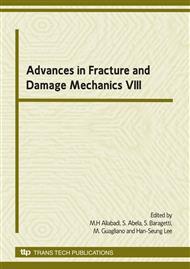p.465
p.469
p.473
p.477
p.481
p.485
p.489
p.493
p.497
Fatigue Test on Integral Joint of the Main Truss of the Baling River Bridge
Abstract:
The Baling River Bridge is a single-span simply-supported suspension bridge with a main span of 1088 m. The steel stiffening truss is employed as its main girder and comprises the integral joints connecting the chord members. The integral joint is a key structure and determines the safety of the bridge, but it is very complex in detail and has an undefined fatigue resistance. In order to investigate its mechanical behavior and fatigue reliability, a fatigue test was performed on a 1:1.4 scale model of the integral joint of the main truss of the Bridge. With an assumption of the load spectra represented by the standard fatigue vehicle in BS 5400, the test fatigue load was derived accounting for the multiple vehicle effect and the model scale. The test result shows that no cracks were detected in the model when subjected to two million stress range cycles, and the structure has an reliable fatigue resistance satisfying the design requirement. This type of integral joint is an alternative for long-span truss bridges.
Info:
Periodical:
Pages:
481-484
Citation:
Online since:
October 2009
Authors:
Keywords:
Price:
Сopyright:
© 2010 Trans Tech Publications Ltd. All Rights Reserved
Share:
Citation:


